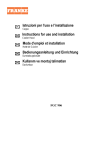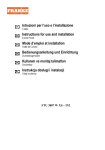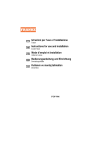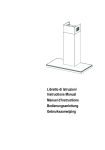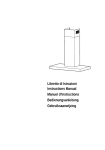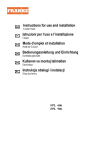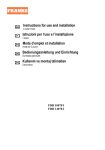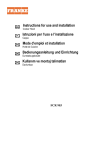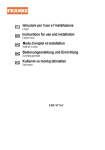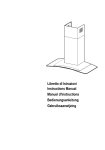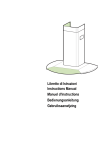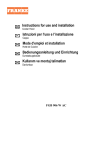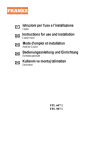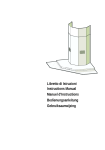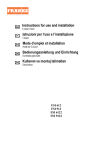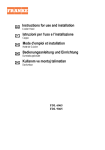Download Istruzioni per l`uso e l`installazione Instructions for use and
Transcript
IT Istruzioni per l’uso e l’installazione Cappa GB Instructions for use and installation FR Mode d’emploi et installation DE Bedienungsanleitung und Einrichtung TR Kullanım ve montaj talimatları PL Instrukcja obsługi i instalacji Cooker Hood Hotte de Cuisine Dunstabzugshaube Davlumbaz Okap kuchenny FMY 907 Libretto di Istruzioni INDICE CONSIGLI E SUGGERIMENTI ..............................................................................................................................................8 CARATTERISTICHE ..............................................................................................................................................................9 INSTALLAZIONE..................................................................................................................................................................10 USO ......................................................................................................................................................................................13 MANUTENZIONE .................................................................................................................................................................14 IT 2 2 Instructions Manual INDEX RECOMMENDATIONS AND SUGGESTIONS ....................................................................................................................16 CHARACTERISTICS............................................................................................................................................................17 INSTALLATION ....................................................................................................................................................................18 USE.......................................................................................................................................................................................21 MAINTENANCE....................................................................................................................................................................22 EN 3 3 Manuel d’Instructions SOMMAIRE CONSEILS ET SUGGESTIONS ..........................................................................................................................................24 CARACTERISTIQUES .........................................................................................................................................................25 INSTALLATION ....................................................................................................................................................................26 UTILISATION........................................................................................................................................................................29 ENTRETIEN..........................................................................................................................................................................30 FR 4 4 Bedienungsanleitung INHALTSVERZEICHNIS EMPFEHLUNGEN UND HINWEISE....................................................................................................................................32 CHARAKTERISTIKEN..........................................................................................................................................................33 MONTAGE............................................................................................................................................................................34 BEDIENUNG.........................................................................................................................................................................37 WARTUNG............................................................................................................................................................................38 DE 5 5 Kullanim Kilavuku IÇERIKLER TAVSIYELER VE ÖNERILER ..............................................................................................................................................40 ÖZELLIKLER ........................................................................................................................................................................41 MONTAJ ...............................................................................................................................................................................42 KULLANIM ............................................................................................................................................................................45 BAKIM...................................................................................................................................................................................46 TR 6 6 Instrukcja Obslugi SPIS TREŚCI UWAGI I SUGESTIE.............................................................................................................................................................48 WŁAŚCIWOŚCI TECHNICZNE............................................................................................................................................49 INSTALACJA ........................................................................................................................................................................50 UŻYTKOWANIE....................................................................................................................................................................53 KONSERWACJA ..................................................................................................................................................................54 PL 7 7 CONSIGLI E SUGGERIMENTI Questo libretto di istruzioni per l'uso è previsto per più versioni dell'apparecchio. Possibile che siano descritti singoli particolari della dotazione, che non riguardano il Vostro apparecchio. INSTALLAZIONE • Il produttore declina qualsiasi responsabilità per danni dovuti ad installazione non corretta o non conforme alle regole dell’arte. • La distanza minima di sicurezza tra il Piano di cottura e la Cappa deve essere di 450 mm. • Verificare che la tensione di rete corrisponda a quella riportata nella targhetta posta all’interno della Cappa. • Per Apparecchi in Classe Ia accertarsi che l’impianto elettrico domestico garantisca un corretto scarico a terra. • Collegare la Cappa all’uscita dell’aria aspirata con tubazione di diametro pari o superiore a 120 mm. Il percorso della tubazione deve essere il più breve possibile. • Non collegare la Cappa a condotti di scarico dei fumi prodotti da combustione (caldaie, caminetti, ecc.). • Nel caso in cui nella stanza vengano utilizzati sia la Cappa che apparecchi non azionati da energia elettrica (ad esempio apparecchi utilizzatori di gas), si deve provvedere ad una aerazione sufficiente dell’ambiente. Se la cucina ne fosse sprovvista, praticare un’apertura che comunichi con l’esterno, per garantire il richiamo d’aria pulita. USO 450 mm min. • La Cappa è stata progettata esclusivamente per uso domestico, per abbattere gli odori della cucina. • Non fare mai uso improprio della Cappa. • Non lasciare fiamme libere a forte intensità sotto la Cappa in funzione. • Regolare sempre le fiamme in modo da evitare una evidente fuoriuscita laterale delle stesse rispetto al fondo delle pentole. • Controllare le friggitrici durante l’uso: l’olio surriscaldato potrebbe infiammarsi. • Non preparare alimenti flambè sotto la cappa da cucina; pericolo d'incendio. • Questo apparecchio non deve essere utilizzato da persone (bambini inclusi) con ridotte capacità psichiche, sensoriali o mentali, oppure da persone senza esperienza e conoscenza, a meno che non siano controllati o istruiti all’uso dell’apparecchio da persone responsabili della loro sicurezza. • I bambini devono essere supervisionati per assicurarsi che non giochino con l’apparecchio. MANUTENZIONE • Prima di procedere a qualsiasi operazione di manutenzione, disinserire la Cappa togliendo la spina elettrica o spegnendo l’interruttore generale. • Effettuare una scrupolosa e tempestiva manutenzione dei Filtri secondo gli intervalli consigliati. • Per la pulizia delle superfici della Cappa è sufficiente utilizzare un panno umido e detersivo liquido neutro. Il simbolo sul prodotto o sulla confezione indica che il prodotto non deve essere considerato come un normale rifiuto domestico, ma deve essere portato nel punto di raccolta appropriato per il riciclaggio di apparecchiature elettriche ed elettroniche. Provvedendo a smaltire questo prodotto in modo appropriato, si contribuisce a evitare potenziali conseguenze negative per l’ambiente e per la salute, che potrebbero derivare da uno smaltimento inadeguato del prodotto. Per informazioni più dettagliate sul riciclaggio di questo prodotto, contattare l’ufficio comunale, il servizio locale di smaltimento rifiuti o il negozio in cui è stato acquistato il prodotto. IT 8 8 CARATTERISTICHE Ingombro 15 Componenti Q.tà Componenti di Prodotto 1 Corpo Cappa completo di: Comandi, Luce, Gruppo Ventilatore, Filtri 2 1 Camino Telescopico formato da: 2.1 1 Camino Superiore 2.2 1 Camino Inferiore 9 1 Flangia di Riduzione ø 150-120 mm 14.1 2 Prolunga Raccordo Uscita Aria 15 1 Raccordo Uscita Aria Rif. Q.tà Componenti di Installazione 7.2.1 2 Staffe Fissaggio Camino Superiore 7.3 1 Staffa Sostegno Raccordo 11 6 Tasselli 12a 6 Viti 4,2 x 44,4 12c 6 Viti 2,9 x 9,5 Q.tà Documentazione 1 Libretto Istruzioni 14.1 Rif. 1 IT 7.3 12a 7.2.1 11 9 2.1 12c 2 2.2 11 12a 1 9 9 INSTALLAZIONE 1÷2 Foratura Parete e Fissaggio Staffe 11 X 7.2.1 116 116 1040 450 mm min 12a Tracciare sulla Parete: • una linea Verticale fino al soffitto o al limite superiore, al centro della zona prevista per il montaggio della Cappa; • una linea Orizzontale a: 1040 mm min. sopra il Piano di Cottura. • Appoggiare come indicato la Staffa 7.2.1 a 1-2 mm dal soffitto o dal limite superiore, allineando il suo centro (intagli) sulla linea Verticale di riferimento. • Segnare i centri dei Fori della Staffa. • Appoggiare come indicato la Staffa 7.2.1 a X mm sotto la prima staffa (X = altezza Camino Superiore in dotazione), allineando il suo centro (intagli) sulla linea Verticale di riferimento. • Segnare i centri dei Fori della Staffa. • Segnare come indicato, un punto di riferimento a 116 mm dalla linea Verticale di riferimento. • Ripetere questa operazione dalla parte opposta. • Forare ø 8 mm i punti segnati. • Inserire i tasselli 11 nei fori. • Fissare la Staffa inferiore 7.2.1 utilizzando le Viti 12a (4,2 x 44,4 ) in dotazione. • Fissare insieme la Staffa superiore 7.2.1 e la Staffa sostegno raccordo 7.3 utilizzando le 2 viti 12a (4,2 x 44,4) in dotazione. • Avvitare 2 Viti 12a (4,2 x 44,4) in dotazione nei fori per il fissaggio del corpo Cappa, lasciando uno spazio di 5-6 mm fra la parete e la testa della vite. IT 1 10 0 Montaggio Corpo Cappa Vr • Prima di agganciare il Corpo Cappa, serrare le 2 Viti Vr situate sui punti di aggancio del Corpo Cappa. • Agganciare il Corpo Cappa alle Viti 12a. • Serrare definitivamente le Viti 12a di supporto. • Agire sulle Viti Vr per livellare il Corpo Cappa. 12a Connessioni USCITA ARIA VERSIONE ASPIRANTE Per installazione in Versione Aspirante collegare la Cappa alla tubazione di uscita per mezzo di un tubo rigido o flessibile di ø150 o 120 mm, la cui scelta è lasciata all'installatore. • Per collegamento con tubo ø120 mm, inserire la Flangia di riduzione 9 sull’Uscita del Corpo Cappa. • Fissare il tubo con adeguate fascette stringitubo. Il materiale occorrente non è in dotazione. • Togliere eventuali Filtri Antiodore al Carbone attivo. ø 150 14.1 USCITA ARIA VERSIONE FILTRANTE • Inserire il Raccordo 15 nella Staffa di Sostegno 7.3. • Inserire lateralmente le Prolunghe Raccordo 14.1 sul Raccordo 15. • Assicurarsi che l’uscita delle Prolunghe Raccordo 14.1 risulti in corrispondenza delle bocchette del Camino sia in orizzontale che in verticale. • Collegare il Raccordo 15 all’Uscita del Corpo Cappa per mezzo di un tubo rigido o flessibile di ø150 mm, la cui scelta è lasciata all'installatore. • Assicurarsi della presenza del Filtro Antiodore al Carbone attivo. IT ø 120 9 15 ø 150 1 11 1 CONNESSIONE ELETTRICA • Collegare la Cappa all’Alimentazione di Rete interponendo un Interruttore bipolare con apertura dei contatti di almeno 3 mm. • Rimuovere i Filtri antigrasso (vedi par. “Manutenzione”) e assicurarsi che il connettore del Cavo di alimentazione sia correttamente inserito nella presa dell’Aspiratore 7.2.1 Montaggio Camino Camino superiore • Allargare leggermente le due falde laterali, agganciarle dietro le Staffe 7.2.1 e richiuderle fino a battuta. • Fissare lateralmente alle Staffe con 4 Viti 12c (2,9 x 9,5) in dotazione. • Assicurarsi che l’uscita delle Prolunghe Raccordo risulti in corrispondenza delle bocchette del Camino. Camino inferiore • Allargare leggermente le due falde laterali del Camino, agganciarle tra il Camino superiore e la parete e richiuderle fino a battuta. • Fissare lateralmente la parte inferiore al Corpo Cappa, con 2 Viti 12c (2,9 x 9,5) in dotazione. IT 12c 2.1 2 12c 2.2 12c 1 12 2 USO A B C D E F G H Quadro comandi Tasto Funzione Display A Accende e spegne il motore di aspirazione Visualizza la velocità impostata all’ultima velocità utilizzata. B Decrementa la velocità di esercizio. C Incrementa la velocità di esercizio. D Attiva la velocità intensiva da qualsiasi velo- Visualizza HI e il punto in basso a destra lamcità anche da motore spento, tale velocità è peggia una volta al secondo. temporizzata a 10 minuti, al termine del tempo il sistema ritorna alla velocità precedentemente impostata. Adatta a fronteggiare le massime emissioni di fumi di cottura. E Attiva il motore ad una velocità che consente un’aspirazione di 100 m3/h per 10 minuti ogni ora, terminati il motore si ferma. F Con l’allarme filtri in corso premendo il tasto Terminata la procedura si spegne la segnalaper circa 3 secondi si effettua il reset dell’al- zione precedentemente visualizzata: larme. Tali segnalazioni sono visibili solo a FF segnala la necessità di lavare i filtri antimotore spento. grasso metallici. L’allarme entra in funzione dopo 100 ore di lavoro effettivo della Cappa. EF segnala la necessità di sostituire i filtri al carbone attivo e devono anche essere lavati i filtri antigrasso metallici. L’allarme entra in funzione dopo 200 ore di lavoro effettivo della Cappa. Visualizza alternativamente la velocità di eserAttiva lo spegnimento automatico ritardato di cizio e il tempo rimanente allo spegnimento 30’. Adatto per completare l’eliminazione di odori residui. Attivabile da qualsiasi posizione, della cappa. Il punto in basso a destra lampeggia. si disattiva premendo il tasto o spegnendo il motore. G Accende e spegne l’impianto di illuminazione. H Accende e spegne l’impianto di illuminazione ad intensità ridotta. IT Visualizza 24 e il punto in basso a destra lampeggia, mentre il motore è in funzione 1 13 3 MANUTENZIONE Pulizia dei Confort Panel • Aprire il Confort Panel tirandolo. • Sganciare il pannello dal corpo cappa facendo scorrere l’apposita leva del perno di fissaggio. • Il confort panel non va assolutamente lavato in lavastoviglie. • Pulirlo esternamente con un panno umido e detersivo liquido neutro. • Pulirlo anche internamente utilizzando un panno umido e detergente neutro; non utilizzare panni o spugne bagnate, né getti d’acqua; non utilizzare sostanze abrasive. • Ad operazione ultimata riagganciare il pannello al corpo cappa e richiuderlo. . Filtri antigrasso metallici Sono lavabili anche in lavastoviglie, e necessitano di essere lavati quando sul display appare FF o almeno ogni 2 mesi circa di utilizzo o più frequentemente, per un uso particolarmente intenso. Reset del segnale di allarme • Spegnere le Luci e il Motore di aspirazione, quindi qualora fosse attivata la funzione 24h disattivarla. • Premere il tasto E sino allo spegnersi del display. Pulizia Filtri • Aprire i Comfort Panel tirandoli. • Togliere i Filtri uno alla volta, spingendoli verso la parte posteriore del gruppo e tirando contemporaneamente verso il basso. • Lavare i Filtri evitando di piegarli, e lasciarli asciugare prima di rimontarli. (Un’eventuale cambiamento del colore della superficie del filtro, che potrebbe verificarsi nel tempo, non pregiudica assolutamente l’efficienza dello stesso.) • Rimontarli facendo attenzione a mantenere la maniglia verso la parte visibile esterna. • Richiudere i comfort panel. IT 1 14 4 Filtri antiodore al Carbone attivo (Versione Filtrante) • Non è lavabile e non è rigenerabile, va sostituito quando sul display appare EF o almeno ogni 4 mesi. Attivazione del segnale di allarme • Nelle Cappe in Versione Filtrante, la segnalazione di Allarme saturazione Filtri va attivata al momento dell’installazione o successivamente. • Spegnere le Luci e il Motore di aspirazione. • Scollegare la cappa dall’alimentazione di rete. • Ripristinare il collegamento tenendo premuto il tasto B. • Rilasciando il tasto sul display compaiono due rettangoli in rotazione. • Entro 3 secondi premere il Tasto B sino alla conferma che appare sul display: • 2 lampeggi scritta EF - Allarme saturazione Filtro Carbone attivo ATTIVATO • 1 lampeggio scritta EF - Allarme saturazione Filtro al Carbone attivo DISATTIVATO. SOSTITUZIONE FILTRO ANTIODORE AL CARBONE ATTIVO Reset del segnale di allarme • Spegnere le Luci e il Motore di aspirazione, quindi qualora fosse attivata la funzione 24h disattivarla. • Premere il tasto E sino allo spegnersi del display. Sostituzione Filtro • Aprire i Comfort Panel tirandoli. • Togliere i Filtri antigrasso metallici. • Rimuovere il Filtro antiodore al Carbone attivo saturo, agendo sugli appositi agganci. • Montare il nuovo Filtro agganciandolo nella sua sede. • Rimontare i Filtri antigrasso metallici. • Richiudere i Comfort Panel. Illuminazione SOSTITUZIONE LAMPADE Lampade alogene da 20 W. • Togliere le due viti che fissano il Supporto illuminazione e sfilarlo dalla Cappa. • Estrarre la Lampada dal Supporto. • Sostituirla con una nuova di uguali caratteristiche, facendo attenzione di inserire correttamente i due spinotti nella sede del Supporto. • Rimontare il Supporto fissandola con le due Viti precedentemente tolte. IT 1 15 5 RECOMMENDATIONS AND SUGGESTIONS The Instructions for Use apply to several versions of this appliance. Accordingly, you may find descriptions of individual features that do not apply to your specific appliance. INSTALLATION • The manufacturer will not be held liable for any damages resulting from incorrect or improper installation. • The minimum safety distance between the cooker top and the extractor hood is 450 mm. • Check that the mains voltage corresponds to that indicated on the rating plate fixed to the inside of the hood. • For Class I appliances, check that the domestic power supply guarantees adequate earthing. Connect the extractor to the exhaust flue through a pipe of minimum diameter 120 mm. The route of the flue must be as short as possible. • Do not connect the extractor hood to exhaust ducts carrying combustion fumes (boilers, fireplaces, etc.). • If the extractor is used in conjunction with non-electrical appliances (e.g. gas burning appliances), a sufficient degree of aeration must be guaranteed in the room in order to prevent the backflow of exhaust gas. The kitchen must have an opening communicating directly with the open air in order to guarantee the entry of clean air. USE 450 mm min. • The extractor hood has been designed exclusively for domestic use to eliminate kitchen smells. • Never use the hood for purposes other than for which it has ben designed. • Never leave high naked flames under the hood when it is in operation. • Adjust the flame intensity to direct it onto the bottom of the pan only, making sure that it does not engulf the sides. • Deep fat fryers must be continuously monitored during use: overheated oil can burst into flames. • Do not flambè under the range hood; risk of fire • This appliance is not intended for use by persons (including children) with reduced physical, sensory or mental capabilities, or lack of experience and knowledge, unless they have been given supervision or instruction concerning use of the appliance by a person responsible for their safety. • Children should be supervised to ensure that they do not play with the appliance. MAINTENANCE • Switch off or unplug the appliance from the mains supply before carrying out any maintenance work. • Clean and/or replace the Filters after the specified time period. • Clean the hood using a damp cloth and a neutral liquid detergent. The symbol on the product or on its packaging indicates that this product may not be treated as household waste. Instead it shall be handed over to the applicable collection point for the recycling of electrical and electronic equipment. By ensuring this product is disposed of correctly, you will help prevent potential negative consequences for the environment and human health, which could otherwise be caused by inappropriate waste handling of this product. For more detailed information about recycling of this product, please contact your local city office, your household waste disposal service or the shop where you purchased the product. EN 1 16 6 CHARACTERISTICS Dimensions 15 Components Q.ty Product Components 1 Hood Body, complete with: Controls, Light, Blower, Filters 2 1 Telescopic Chimney comprising: 2.1 1 Upper Section 2.2 1 Lower Section 9 1 Reducer Flange ø 150-120 mm 14.1 2 Air Outlet Connection Extension 15 1 Air Outlet Connection Ref. Q.ty Installation Components 7.2.1 2 Upper Chimney Section Fixing Brackets 7.3 1 Air Outlet Connection Support 11 6 Wall Plugs 12a 6 Screws 4,2 x 44,4 12c 6 Screws 2,9 x 9,5 Q.ty Documentation 1 Instruction Manual 14.1 Ref. 1 EN 7.3 12a 7.2.1 11 9 2.1 12c 2 2.2 11 12a 1 1 17 7 INSTALLATION 1÷2 Wall drilling and bracket fixing 11 X 7.2.1 116 116 1040 450 mm min 12a Wall marking: • Draw a vertical line on the supporting wall up to the ceiling, or as high as practical, at the centre of the area in which the hood will be installed. • Draw a horizontal line at 1040 mm above the hob. • Place bracket 7.2.1 on the wall as shown about 1-2 mm from the ceiling or upper limit aligning the centre (notch) with the vertical reference line. • Mark the wall at the centres of the holes in the bracket. • Place bracket 7.2.1 on the wall as shown at X mm below the first bracket (X = height of the upper chimney section supplied), aligning the centre (notch) with the vertical line. • Mark the wall at the centres of the holes in the bracket. • Mark a reference point as indicated at 116 mm from the vertical reference. • Repeat this operation on the other side. • Drill ø 8 mm holes at all the centre points marked. • Insert the wall plugs 11 in the holes. • Fix the lower bracket 7.2.1 using the 12a screws (4,2 x 44,4) supplied. • Fix the upper bracket 7.2.1 and the air outlet connection support 7.3 together using the 2 screws 12a (4,2 x 44,4) supplied. • Insert the two screws 12a (4,2 x 44,4) supplied in the hood body fixing holes, leaving a gap of 5-6 mm between the wall and the head of the screw. EN 1 18 8 Mounting the hood body Vr • Before attaching the hood body, tighten the two screws Vr located on the hood body mounting points. • Hook the hood body onto the screws 12a. • Fully tighten support screws 12a. • Adjust screws Vr to level the hood body. 12a Connections DUCTED VERSION AIR EXHAUST SYSTEM When installing the ducted version, connect the hood to the chimney using either a flexible or rigid pipe ø 150 or 120 mm, the choice of which is left to the installer. • To install a ø 120 mm air exhaust connection, insert the reducer flange 9 on the hood body outlet. • Fix the pipe in position using sufficient pipe clamps (not supplied). • Remove any activated charcoal filters. ø 150 14.1 RECIRCULATION VERSION AIR OUTLET • Put connection 15 into the connection support 7.3. • Insert the connection extension pieces laterally 14.1 in connection 15. • Make sure that the outlet of the extension pieces 14.1 is horizontally and vertically aligned with the chimney outlets. • Connect the air outlet connection 15 to the hood body outlet using either a flexible or rigid pipe ø 150 mm, the choice of which is left to the installer. • Ensure that the activated charcoal filters have been inserted. EN ø 120 9 15 ø 150 1 19 9 ELECTRICAL CONNECTION • Connect the hood to the mains through a two-pole switch having a contact gap of at least 3 mm. • Remove the grease filters (see paragraph Maintenance) being sure that the connector of the feeding cable is correctly inserted in the socket placed on the side of the fan. 7.2.1 Flue assembly Upper exhaust flue • Slightly widen the two sides of the upper flue and hook them behind the brackets 7.2.1, making sure that they are well seated. • Secure the sides to the brackets using the 4 screws 12c (2,9 x 9,5) supplied. • Make sure that the outlet of the extensions pieces is aligned with the chimney outlets. 12c 2.1 2 12c 2.2 12c Lower exhaust flue • Slightly widen the two sides of the flue and hook them between the upper flue and the wall, making sure that they are well seated. • Fix the lower part laterally to the hood body using the 2 screws 12c (2,9 x 9,5) supplied. EN 2 20 0 USE A B C D E F G H Control board Key B Function Display Switches the extractor motor on and off at the Indicates the selected speed. latest selected speed Decreases the suction speed. C Increases the suction speed. D By pressing this key it is possible to activate HI appears. The spot down on the right side the intensive speed from any previously se- flashes once a second. lected speed. The intensive speed can be activated even when the motor is OFF. This speed has been timed at 10 minutes. After that time the system activates automatically the latest selected speed. This function is suitable for cooking conditions when vapours and smells are of the utmost emission. E By pressing this key it is possible to set up the motor to a suction speed at 100 m3/h lasting 10 minutes every hour. After this the motor switches off automatically. When the filter saturation is going on it is possible to reset the alarm by pressing this key for about 3 seconds. The indication is visible only when the motor is off. A Indicates the 24-function. The spot down on the right side flashes and the motor is on. G Once the process is finished the previous indication disappears: FF Indicates that the metal grease filters saturation alarm has been triggered, and the filters need to be washed. The alarm is triggered after 100 working hours. EF Indicates that the charcoal filter saturation alarm has been triggered, and the filter has to be replaced; the metal grease filters must also be washed. The charcoal filter is triggered after 200 working hours. By pressing this key it is possible to set the Indicates alternately the selected speed of the delayed shutdown of the appliance to 30 min- hood and the time left before the hood shututes. This function is suitable for a complete down. The spot down on the right side flashes. elimination of the residual smells. It can be activated at any position, and it is deactivated by pressing the key again or by switching off the motor. Turns light on and off . H Turns light on and off at reduced intensity. F EN 2 21 1 MAINTENANCE Cleaning the Comfort Panels • Pull the Comfort Panel to open it. • Disconnect the panel from the hood canopy by sliding the fixing pin lever. • The comfort panel must never be washed in a dishwasher. • Clean the outside using a damp cloth and neutral liquid detergent. • Clean the inside as well using a damp cloth and neutral detergent; do not use wet cloths or sponges, or jets of water; do not use abrasive substances. • When the above operation has been completed, hook the panel back to the hood canopy and close it by turning the knob in the opposite direction. Metal grease filters Filters can be washed in the dish machine. They need to be washed when FF-sign appears on the display or in any case every 2 months, or even more frequently in case of particularly intensive use of the hood. Alarm reset • Switch off the hood and the lights. If the 24h-function has been activated this has to be deactivated. • Press the E-key till the display is unlit. Cleaning the filters • Pull the comfort panels to open them. • Remove the filters one by one pushing them towards the back side of the hood unit and simultaneously pulling downwards. • Any kind of bending of the filters has to be avoided when washing them. Before fitting them again into the hood make sure that they are completely dry. (The colour of the filter surface may change throughout the time but this has no influence to the filter efficiency). • When fitting the filters into the hood pay attention that they are mounted in correct position the handle facing outwards. • Close the comfort panel. EN 2 22 2 Charcoal filter (recycling version) • This filter cannot be washed or regenerated. It must be replaced when the EF appears on the display or at least once every 4 months. Activation of the alarm signal • In the recycling version hoods the filter saturation alarm must be activated during the installation or later. • Switch off the hood and the lights. • Disconnect the hood from the mains supply. • When restoring the connection press and hold B-key. • When releasing the key two rotating rectangles appear on the display. • Within 3 seconds press the B-key until a flashing confirmation appears on the dispaly: • 2 flashes with EF - charcoal filter saturation alarm ACTIVATED • 1 flash with EF - charcoal filter saturation alarm DEACTIVATED. REPLACING THE CHARCOAL FILTER Reset of the alarm signal • Switch off the hood and the lighting. If the 24h-function has been activated this has to be deactivated. • Press the E-key until the display is unlit. Replacing of the filter • Open the comfort panels pulling them downwards. • Remove the metal grease filters. • Remove the saturated charcoal filter by releasing the fixing hooks • Fit the new filter and fasten it in its correct position. • Put the metal grease filters in their seats. • Close the comfort panels. Lighting LIGHT REPLACEMENT 20 W halogen light. • Remove the 2 screws fixing the Lighting support, and pull it out of from the Hood. • Extract the lamp from the Support. • Replace with another of the same type, making sure that the two pins are properly inserted in the lamp holder socket holes. • Replace the Support, fixing it in place with the two screws removed as above. EN 2 23 3 CONSEILS ET SUGGESTIONS La présente notice d'emploi vaut pour plusieurs versions de l'appareil. Elle peut contenir des descriptions d'accessoires ne figurant pas dans votre appareil. INSTALLATION • Le fabricant décline toute responsabilité en cas de dommage dû à une installation non correcte ou non conforme aux règles de l’art. • La distance minimale de sécurité entre le plan de cuisson et la hotte doit être de 450 mm au moins. • Vérifier que la tension du secteur correspond à la valeur qui figure sur la plaquette apposée à l’intérieur de la hotte. • Pour les Appareils appartenant à la Ière Classe, veiller à ce que la mise à la terre de l’installation électrique domestique ait été effectuée conformément aux normes en vigueur. • Connecter la hotte à la sortie d’air aspiré à l’aide d’une tuyauterie d’un diamètre égal ou supérieur à 120 mm. Le parcours de la tuyauterie doit être le plus court possible. • Eviter de connecter la hotte à des conduites d’évacuation de fumées issues d’une combustion tel que (Chaudière, cheminée, etc…). • Si vous utilisez des appareils qui ne fonctionnent pas à l’électricité dans la pièce ou est installée la hotte (par exemple: des appareils fonctionnant au gaz), vous devez prévoir une aération suffisante du milieu. Si la cuisine en est dépourvue, pratiquez une ouverture qui communique avec l’extérieur pour garantir l’infiltration de l’air pur. UTILISATION 450 mm min. • La hotte a été conçue exclusivement pour l’usage domestique, dans le but d’éliminer les odeurs de la cuisine. • Ne jamais utiliser abusivement la hotte. • Ne pas laisser les flammes libres à forte intensité quand la hotte est en service. • Toujours régler les flammes de manière à éviter toute sortie latérale de ces dernières par rapport au fond des marmites. • Contrôler les friteuses lors de l’utilisation car l’huile surchauffée pourrait s’enflammer. • Ne pas préparer d’aliments flambés sous la hotte de cuisine : risque d’incendie • Cet appareil ne doit pas être utilisé par des personnes (y compris les enfants) ayant des capacités psychiques, sensorielles ou mentales réduites, ni par des personnes n’ayant pas l’expérience et la connaissance de ce type d’appareils, à moins d'être sous le contrôle et la formation de personnes responsables de leur sécurité. • Les enfants doivent être surveillés pour s'assurer qu'ils ne jouent pas avec l'appareil. ENTRETIEN • Avant de procéder à toute opération d’entretien, retirer la hotte en retirant la fiche ou en actionnant l’interrupteur général. • Effectuer un entretien scrupuleux et en temps dû des Filtres, à la cadence conseillée. • Pour le nettoyage des surfaces de la hotte, il suffit d’utiliser un chiffon humide et détersif liquide neutre. Le symbole sur le produit ou son emballage indique que ce produit ne peut être traité comme déchet ménager. Il doit plutôt être remis au point de ramassage concerné, se chargeant du recyclage du matériel électrique et électronique. En vous assurant que ce produit est éliminé correctement, vous favorisez la prévention des conséquences négatives pour l’environnement et la santé humaine qui, sinon, seraient le résultat d’un traitement inapproprié des déchets de ce produit. Pour obtenir plus de détails sur le recyclage de ce produit, veuillez prendre contact avec le bureau municipal de votre région, votre service d’élimination des déchets ménagers ou le magasin où vous avez acheté le produit. FR 2 24 4 CARACTERISTIQUES Encombrement 15 Composants Q.té Composants de Produit 1 Corps Hotte équipé de:Commandes, Lumière, Groupe Ventilateur,Filtres 2 1 Cheminée Télescopique formée de : 2.1 1 Cheminée Supérieure 2.2 1 Cheminée Inférieure 9 1 Flasque de Réduction ø 150-120 mm 14.1 2 Rallonge Raccord Sortie Air 15 1 Raccord Sortie Air Réf. Q.té Composants pour l ’installation 7.2.1 2 Brides Fixation Cheminée Supérieure 7.3 1 Bride Support Raccord 11 6 Chevilles 12a 6 Vis 4,2 x 44,4 12c 6 Vis 2,9 x 9,5 Q.té Documentation 1 Manuel d’instructions 14.1 Réf. 1 FR 7.3 12a 7.2.1 11 9 2.1 12c 2 2.2 11 12a 1 2 25 5 INSTALLATION 1÷2 Perçage Paroi et Fixation Brides 11 X 7.2.1 116 116 1040 450 mm min 12a Tracer sur la paroi: • une ligne verticale allant jusqu’au plafond ou à la limite supérieure, au centre de la zone prévue pour le montage de la hotte; • une ligne horizontale à 1040 mm min. au-dessus du plan de cuisson. • Poser comme indiqué une bride 7.2.1 sur la paroi à 1-2 mm du plafond ou de la limite supérieure, en alignant son centre (découpes) sur la ligne verticale de repère. • Marquer les centres des trous rainurés de la bride. • Poser comme indiqué la bride 7.2.1 à X mm sous la première bride (X = hauteur cheminée supérieure fournie), en alignant son centre (découpes) sur la ligne verticale de repère. • Marquer les centres des trous rainurés de la bride. • Marquer comme indiqué, un point de référence à 116 mm de la ligne verticale de repère. • Répéter cette opération sur le côté opposé. • Percer de ø 8 mm tous les points marqués. • Insérer les chevilles 11 dans les trous. • Fixer la bride inférieure 7.2.1 en utilisant les vis 12a (4,2 x 44,4) fournies. • Fixer ensemble la bride supérieure 7.2.1 et le support 7.3 en utilisant les vis 12a (4,2 x 44,4) fournies. • Visser les 2 vis 12a (4,2 x 44,4) fournies dans les trous de fixation du corps hotte, en laissant un espace de 5-6 mm entre le mur et la tête de la vis. FR 2 26 6 Montage Corps Hotte Vr • Avant d’accrocher le corps hotte, serrer les deux vis Vr situées sur les points d’accrochage du corps hotte. • Accrocher le corps hotte aux vis 12a prévues à cet effet. • Serrer définitivement les vis 12a de support. • Agir sur les vis Vr pour niveler le corps hotte. 12a Branchements SORTIE AIR VERSION ASPIRANTE En cas d’installation en version aspirante, brancher la hotte à la tuyauterie de sortie via un tube rigide ou flexible de ø 150 ou 120 mm, au choix de l’installateur. • En cas de branchement avec un tube de ø120 mm, insérer le flasque de réduction 9 sur la sortie du corps de la hotte. • Fixer le tube par des colliers appropriés. Le matériau nécessaire n’est pas fourni. • Retirer les éventuels filtres anti-odeur au charbon actif. ø 150 14.1 SORTIE AIR VERSION FILTRANTE • Insérer le raccord 15 dans le support 7.3. • Insérer latéralement les rallonges raccord 14.1 sur le raccord 15. • S’assurer que la sortie des rallonges raccord 14.1 se trouve au niveau des bouches de la cheminée aussi bien en horizontal qu’en vertical. • Brancher le raccord 15 à la sortie du corps de la hotte avec un tube rigide ou flexible de ø 150 mm, selon le choix de l’installateur. • S’assurer de la présence des filtres anti-odeur au charbon actif. FR ø 120 9 15 ø 150 2 27 7 BRANCHEMENT ELECTRIQUE • Brancher la hotte sur le secteur en interposant un interrupteur bipolaire avec ouverture des contacts d’au moins 3 mm. • Enlever les filtres à graisse (voir § "Entretien") et s'assurer que le connecteur du câble d'alimentation soit bien branché dans la prise du diffuseur. 7.2.1 Montage Cheminée Cheminée supérieure • Elargir légèrement les deux bords latériaux, et les accrocher derrières les brides 7.2.1 ; refermer jusqu’à la butée. • Fixer latéralement aux brides à l’aide des 4 vis 12c fournies. • S’assurer que la sortie des rallonges raccord se trouve au niveau des bouches de la cheminée. 12c 2.1 2 12c 2.2 12c Cheminée inférieure • Elargir légèrement les deux bords latériaux de la Cheminée et les accrocher entre la Cheminée supérieure et la paroi; refermer jusqu’à la butée. • Fixer latéralement la partie inférieure au corps hotte, à l’aide des deux 2 vis 12c fournies. FR 2 28 8 UTILISATION A B C D E F G H Tableau des commandes Touche Fonction A Allume et éteint le moteur d’aspiration à la dernière vitesse utilisée B Diminue la vitesse de service C Augmente la vitesse de service D Active la vitesse intensive à partir de n’importe quelle vitesse, même du moteur arrêté. Cette vitesse est programmée pour durer 10 minutes, après quoi le système retourne à la vitesse réglée au préalable. Sert à faire face à une quantité maximale de fumées de cuisson. E Active le moteur à une vitesse permettant une aspiration de 100 m3/h pendant 10 minutes toutes les heures, puis le moteur s’arrête. F G H FR Afficheur Affiche la vitesse choisie Affiche HI et le point en bas à droite clignote une fois par seconde. Affiche 24 et le point en bas à droite clignote, quand le moteur fonctionne. Quand l’alarme filtres est déclenchée, En fin de procédure, le signal affiché appuyer sur cette touche pendant 3 secondes précédemment s’éteint : environ pour remettre l’alarme à l’état FF indique qu’il faut laver les filtres à initial. Ces indications sont visibles graisse métalliques. L’alarme se uniquement quand le moteur est éteint. déclenche après 100 heures de fonctionnement effectif de la hotte. EF indique qu’il faut remplacer les filtres au charbon actif et laver les filtres à graisse métalliques. L’alarme se déclenche après 200 heures de fonctionnement effectif de la hotte. Active l’arrêt automatique retardé de 30 Affiche tout à tour la vitesse de service et le minutes. Utile pour achever d’éliminer toute temps restant avant l’arrêt de la hotte. Le point odeur résiduelle. S’active depuis toutes les en bas à droite clignote. positions et se désactive en appuyant sur la touche ou en éteignant le moteur. Allume et éteint l’éclairage. Allume et éteint l’éclairage à intensité réduite. 2 29 9 ENTRETIEN Nettoyage des Confort Panel • Ouvrir le Confort Panel, en tirant ce dernier. • Décrocher le panneau du corps de la hotte, en faisant coulisser le levier du goujon de fixation spécialement prévu. • En aucun cas, le confort panel ne doit être lavé au lavevaisselle. • Le nettoyer à l’extérieur à l’aide d’un chiffon humide et d’un détergent liquide neutre. • Le nettoyer également à l’intérieur, en utilisant un chiffon humide et un détergent neutre; ne pas utiliser des chiffons ou des éponges mouillées, ni des jets d’eau; ne pas utiliser des substances abrasives. • Lorsque l‘opération est achevée, accrocher à nouveau le panneau sur le corps de la hotte, puis le refermer, en tournant le bouton dans le sens inverse par rapport à l’ouverture. Filtres à graisse métalliques Ils sont lavables même en lave-vaisselle et doivent être lavés chaque fois que le symbole FF s’affiche ou environ tous les 2 mois ou plus souvent même, en cas d’utilisation particulièrement intensive. Rétablissement du signal d’alarme • Eteint les lumières et le moteur d’aspiration; au cas où la fonction 24h est active, il convient de la désactiver. • Appuyer sur la touche E jusqu’à ce que l’afficheur s’éteigne. Nettoyage des filtres • Tirer sur les panneaux confort pour les ouvrir. • Retirer les filtres, un à un, en les poussant vers la partie postérieure du groupe tout en tirant vers le bas. • Laver les filtres en évitant de les plier, et les faire sécher avant de les remonter. (Tout changement de couleur sur la surface du filtre, susceptible de se produire avec le temps, ne nuit en rien à l’efficacité de ce dernier.) • Remonter les filtres en faisant attention de tenir la poignée vers la partie externe visible. • Refermer les panneaux confort. FR 3 30 0 Filtre anti-odeur au charbon actif (version filtrante) • Il ne peut être ni lavé ni récupéré, il faut le changer quand EF s’affiche ou au moins tous les 4 mois. Déclenchement du signal d’alarme • Pour les Hottes en Version Filtrante, l’alarme indiquant la saturation des Filtres doit être activée au moment de l’installation ou ultérieurement. • Éteindre les lumières et le moteur d’aspiration. • Débrancher la hotte du réseau électrique. • Rétablir le branchement en appuyant sur la touche B. • Lâcher la touche et deux rectangles en rotation apparaissent sur l’afficheur. • Dans les 3 secondes qui suivent, appuyer sur la touche B jusqu’à ce que s’affichent : • EF clignotant deux fois – Alarme saturation filtre charbon active VALIDEE. • EF clignotant un fois – Alarme saturation filtre charbon active INVALIDEE. REMPLACEMENT DU FILTRE ANTI-ODEUR AU CHARBON ACTIF Rétablissement du signal d’alarme • Eteint les lumières et le moteur d’aspiration; au cas où la fonction 24h est active, il convient de la désactiver. • Appuyer sur la touche E jusqu’à ce que l’afficheur s’éteigne. Changement des Filtres • Tirer sur les panneaux confort pour les ouvrir. • Retirer les filtres à graisse métalliques. • Retirer le filtre anti-odeur au charbon actif saturé en agissant sur les crochets qui le tiennent en place. • Mettre le nouveau filtre en l’accrochant bien en place. • Remonter les filtres à graisse métalliques. • Refermer les panneaux confort. Eclairage REMPLACEMENT LAMPES Lampe halogène de 20 W. • Retirer les 2 Vis qui fixent le Support éclairage et ôter ce dernier de la Hotte. • Extraire la Lampe du Support. • Remplacer par une nouvelle lampe possédant les mêmes caractéristiques, en veillant à ce que les deux fiches soient correctement insérées dans le logement de la Douille. • Remonter le Support en le fixant à l’aide des deux Vis précédemment retirées. FR 3 31 1 EMPFEHLUNGEN UND HINWEISE Diese Gebrauchsanleitung gilt für mehrere Geräte-Ausführungen. Es ist möglich, dass einzelne Ausstattungsmerkmale beschrieben sind, die nicht auf Ihr Gerät zutreffen. MONTAGE • Das Gerät darf nur vom Fachpersonal angeschlossen werden. • Der Hersteller haftet nicht für Schäden, die auf eine fehlerhafte und unsachgemäße Montage zurückzuführen sind. • Der minimale Sicherheitsabstand zwischen Kochmulde und Haube muss 450 mm betragen. • Prüfen, ob die Netzspannung mit dem Wert auf dem im Haubeninneren angebrachten Schild übereinstimmt. • Bei Geräten der Klasse I ist sicherzustellen, dass die elektrische Anlage des Wohnhauses über eine vorschriftsmäßige Erdung verfügt. • Das Anschlussrohr der Haube zur Luftaustrittsöffnung sollte möglicherweise einen Durchmesser von 150 mm aufweisen. Der Rohrverlauf muss so kurz wie möglich sein. • Die Haube darf an keine Entlüftungsschächte angeschlossen werden, in die Verbrennungsgase (Heizkessel, Kamine usw.) geleitet werden. • Werden im Raum außer der Dunstabzugshaube andere, nicht elektrisch betriebene (z.B. gasbetriebene) Geräte verwendet, muss für eine ausreichende Belüftung gesorgt werden. Sollte die Küche diesbezüglich nicht entsprechen, ist an einer Aussenwand eine Öffnung anzubringen, die Frischluftzufuhr gewährleistet. BEDIENUNG • Die Dunstabzugshaube ist ausschließlich zum Einsatz im privaten Haushalt und zur Beseitigung von Küchengerüchen vorgesehen. • Bei unsachgemäßer Benutzung wird keine Haftung übernommen. Achtung! Große Flammen bei eingeschalteter Haube niemals unbedeckt lassen. • Die Intensivität der Flamme ist so zu regulieren, dass sie den Topfboden nicht überragt. Achtung! Frittiergeräte müssen während des Gebrauchs stets beaufsichtigt werden: Überhitztes Öl kann sich entzünden. • Keine flambierten Speisen unter der Abzugshaube zubereiten: Brandgefahr. • Dieses Gerät darf nicht von Personen, auch Kindern, mit verminderten psychischen, sensorischen und geistigern Fähigkeiten, oder von Personen ohne Erfahrung und Kenntnisse benutzt werden, sofern sie nicht von für ihre Sicherheit verantwortlichen Personen beaufsichtigt und beim Gebrauch des Geräts angeleitet werden. • Kinder dürfen sich nicht unbeaufsichtigt in der Nähe des Geräts aufhalten und auf keinen Fall mit dem Gerät spielen. 450 mm min. WARTUNG • Bevor Wartungsarbeiten durchgeführt werden, muss die Stromzufuhr zur Haube unterbrochen werden, indem der Stecker gezogen oder der Hauptschalter abgeschaltet wird. • Bei der Filterwartung müssen die vom Hersteller empfohlenen Zeiträume zum Austauschen der Filter genauestens eingehalten werden. • Zur Reinigung der Haubenflächen Wir empfehlen ein feuchtes Tuch und ein mildes Flüssigreinigungsmittel. • Bitte keine Reinigungsmittel mit Scheuermittel verwenden. Die Oberfläche wird damit verkratzt. Das Symbol auf dem Produkt oder seiner Verpackung weist darauf hin, dass dieses Produkt nicht als normaler Haushaltsabfall zu behandeln ist, sondern an einem Sammelpunkt für das Recycling von elektrischen und elektronischen Geräten abgegeben werden muss. Durch Ihren Beitrag zum korrekten Entsorgen dieses Produkts schützen Sie die Umwelt und die Gesundheit Ihrer Mitmenschen. Umwelt und Gesundheit werden durch falsches Entsorgen gefährdet. Weitere Informationen über das Recycling dieses Produkts erhalten Sie von Ihrem Rathaus, Ihrer Müllabfuhr oder dem Geschäft, in dem Sie das Produkt gekauft haben. DE 3 32 2 CHARAKTERISTIKEN Platzbedarf 15 Komponenten Pos. 1 St. 1 2 2.1 2.2 9 14.1 15 1 1 1 1 2 1 Produktkomponenten Haubenkörper mit Schaltern, Beleuchtung, Gebläsegruppe, Filter Teleskopkamin bestehend aus: oberer Kaminteil unterer Kaminteil Reduzierflansch ø 150-120 mm Verlängerung Luftaustritt-Anschlussstück Luftaustritt-Anschlussstück Pos. 7.2.1 7.3 11 12a 12c St. 2 1 6 6 6 Montagekomponenten Befestigungsbügel oberer Kaminteil Bügel für Anschlusshalter Dübel Schrauben 4,2 x 44,4 Schrauben 2,9 x 9,5 St. 1 Dokumentation Bedienungsanleitung 14.1 7.3 12a 7.2.1 11 9 2.1 12c 2 2.2 11 12a 1 DE 3 33 3 MONTAGE 1÷2 Bohren der Befestigungslöcher und Fixieren der Befestigungsbügel 11 X 7.2.1 116 116 1040 450 mm min 12a Achtung: Bitte beachten Sie bei der Montage das Gewicht der kompletten Haube. Die Tragfähigkeit der Decke oder alternativ der Trägerplatte für diese Zugbelastung muss vor der Montage geprüft und gegebenenfalls durch die Anbringung von geeigneten Befestigungs- oder Stabilisierungselementen hergestellt werden. Kann eine hinreichende Tragfähigkeit nicht sichergestellt werden, ist von einer Montage abzusehen. Nachstehende Linien an die Wand zeichnen: • eine vertikale Linie bis zur Decke oder oberen Begrenzung, und zwar in der Mitte des Bereiches, in dem die Haube montiert werden soll; • eine horizontale Linie: mit einem minimalen Abstand von 1040 mm zur Kochfläche. • Einen Bügel 7.2.1 zirka 1-2 mm unter der Decke oder oberen Begrenzung an die Wand legen und seinen Mittelpunkt (Einschnitte) auf die vertikale Bezugslinie ausrichten. • Die Mitte der beiden Bügellöcher an der Wand markieren. • Den zweiten Bügel 7.2.1 an die Wand legen, wobei ein Abstand X mm vom oberen Bügel einzuhalten ist (X = Höhe des jeweiligen oberen Kaminteils); den Mittelpunkt (Einschnitte) auf die vertikale Bezugslinie ausrichten. • Die Mitte der Bügellöcher an der Wand markieren. • Wie beschrieben einen Bezugspunkt 116 mm von der vertikalen Bezugslinie kennzeichnen. • Gleichermaßen an der gegenüberliegenden Seite vorgehen. • Mit einem Bohrer ø 8 mm die markierten Punkte bohren. • Die Dübel 11 in die Bohrungen einfügen. • Den unteren Bügel mit den mitgelieferten Schrauben 12a (4,2 x 44,4) fixieren. • Den Bügel für Anschlusshalter mit den 2 mitgelieferten Schrauben 12a (4,2 x 44,4) auf den oberen Bügel 7.2.1 befestigen. • 2 der mitgelieferten Schrauben 12a (4,2 x 44,4) bei den Befestigungslöchern des Haubenkörpers einschrauben, wobei zwischen Wand und Schraubenkopf ein Freiraum von 5-6 mm zu belassen ist. DE 3 34 4 Montage des Haubenkörpers Vr • Bevor der Haubenkörper eingehakt wird, die 2 Schrauben Vr bei den Haubenkörper-Anhakpunkten festziehen. • Den Haubenkörper bei den Schrauben 12a einhängen. • Die Halteschrauben 12a definitiv festziehen. • Den Haubenkörper mit Hilfe der Schrauben Vr ausrichten. 12a Anschluss der Abluftversion Bei Abluftbetrieb kann die Haube vom Installateur wahlweise mittels Rohr oder Schlauch (ø 150 oder 120 mm) an die Außenrohrleitung angeschlossen werden. • Bei Verwendung eines Anschlussrohres ø 120 den Reduzierflansch 9 am Haubenaustritt anbringen. • Das Rohr mit geeigneten Rohrschellen fixieren. Das hierzu erforderliche Material wird nicht mitgeliefert. • Eventuell vorhandene Aktivkohlefilter entnehmen. ø 150 ø 120 9 Achtung! Alle Querschnittänderungen oder Richtungsänderungen des Abluftkanals reduzieren die Leistung der Haube. 14.1 Anschluss der Umluftversion • Den Anschluss 15 am Anschlusshalter 7.3 anbringen. • Die Verlängerungen 14.1 beim Anschluss 15 seitlich einfügen. • Überprüfen, ob die Verlängerungen 14.1 mit den entsprechenden Kaminstutzen sowohl horizontal wie auch vertikal übereinstimmen. • Vom Installateur wahlweise mittels Rohr oder Schlauch (ø 150 mm), den Anschluss 15 am Haubenaustritt anbringen. • Kontrollieren, ob der Aktivkohle-Geruchsfilter montiert ist. DE 15 ø 150 3 35 5 Elektroanschluss • • Vor der Installation die Netzspannung durch herausdrehen der Sicherung oder ausschalten des Hauptschalters stromlos machen. Bei Anschluss der Haube an das Stromnetz muss ein zweipoliger Schalter mit einem Öffnungsweg von mindestens 3 mm zwischengeschaltet werden. Entfernen Sie die Fettfilter (s. Abschnitt „Wartung“) und versichern Sie sich, daß die Kabelverbindung in die Steckdose des Gebläses einwandfrei eingesteckt wird. Achtung: Das Gerät nur an die Netzspannung die im Typenschild angegeben ist anschließen. 7.2.1 Kaminmontage Oberer Kaminteil • Die beiden seitlichen Schenkel leicht auseinanderbiegen, hinter den Bügeln 7.2.1 einhängen und bis zum Anschlag wieder schließen. • Bei den Bügeln 7.2.1 mit Hilfe der 4 mitgelieferten Schrauben 12c fixieren. • Überprüfen, ob die Verlängerungen mit den entsprechenden Kaminstutzen übereinstimmen. 12c 2.1 2 12c 2.2 12c Unterer Kaminteil • Die beiden seitlichen Schenkel des Kaminteils leicht auseinander biegen, zwischen dem oberen Kaminteil und der Wand einhängen und bis zum Anschlag wieder schließen. • Den unteren Teil seitlich am Haubenkörper mit 2 der mitgelieferten Schrauben 12c fixieren. DE 3 36 6 BEDIENUNG A B C D E F G H Bedienblende Taste Funktion A Schaltet den Motor der Absauganlage bei der zuletzt verwendeten Geschwindigkeit ein und aus. B Vermindert die Betriebsgeschwindigkeit. C Erhöht die Betriebsgeschwindigkeit. D Aktiviert von jeder Geschwindigkeit aus, auch bei abgestelltem Motor, die Intensivgeschwindigkeit, die auf 10 Minuten zeitgeregelt ist. Nach Ablauf dieser Zeit kehrt das System zu der zuvor eingestellten Geschwindigkeit zurück. Für die Beseitigung von sehr intensiven Kochdünsten geeignet. E Aktiviert den Motor bei einer Geschwindigkeit, die eine Absaugleistung von 100 m3/h für die Dauer von 10 Minuten jede Stunde ermöglicht, nach dessen Ablauf hält der Motor an. Bei laufendem Filteralarm wird durch 3 Sekunden anhaltendes Drücken der Taste ein Reset des Alarms ausgelöst. Derlei Anzeigen sind nur bei abgestelltem Motor sichtbar. F G H DE Aktiviert das automatische Ausschalten mit einer Verzögerung von 30 Min. Ermöglicht die Beseitigung von Restgerüchen und kann von jeder Position aus aktiviert werden. Zum Deaktivieren die Taste drücken oder den Motor abstellen. Schaltet die Beleuchtung ein oder aus. Schaltet die verminderte Beleuchtung ein oder aus. Display Zeigt die eingestellte Geschwindigkeit an Zeigt HI an und der Punkt unten rechts blinkt einmal pro Sekunde. Zeigt 24 an und der Punkt unten rechts blinkt, während der Motor in Betrieb ist Nach abgeschlossener Prozedur verlöscht die bisherige Anzeige: FF zeigt an, dass der Metallfettfilter gewaschen werden muss. Dieser Alarm wird nach 100 effektiven Betriebsstunden der Abzugshaube ausgelöst. EF zeigt an, dass die Aktivkohlefilter ausgewechselt und die Metallfettfilter gewaschen werden müssen. Dieser Alarm wird nach 200 effektiven Betriebsstunden der Abzugshaube ausgelöst. Zeigt abwechselnd die Betriebsgeschwindigkeit und die bis zum Abschalten der Abzugshaube verbleibende Zeit an. Der Punkt unten rechts blinkt. 3 37 7 WARTUNG Reinigung der Comfort Panel • Den Comfort Panel durch Ziehen öffnen. • Die Platte vom Haubenkörper aushaken, indem der Hebel des Befestigungsstiftes verschoben wird. • Die Comfort Panel darf keinesfalls im Geschirrspüler gewaschen werden. • Außen mit einem feuchten Lappen und neutralem Flüssigreiniger säubern. • Innen mit einem feuchten Lappen und neutralem Reinigungsmittel säubern; keine nassen Lappen oder Schwämme oder Wasserstrahl verwenden; kein Scheuermittel verwenden. • Am Ende die Platte wieder am Haubenkörper einhaken und schließen, indem der Drehknopf in die dem Öffnen entgegengesetzte Richtung gedreht wird. Metallfettfilter Die Fettfilter sind spülmaschinengeeignet und müssen gewaschen werden, sobald am Display die Aufschrift FF erscheint oder mindestens alle 2 Monate, oder auch öfter, je nach Intensität des Gebrauchs. Reset des Alarmsignals • Die Beleuchtung und den Absaugmotor abschalten und dann die 24-Stunden-Funktion deaktivieren, falls diese zuvor aktiv war. • Die Taste E drücken, bis das Display verlöscht. Reinigung der Filter • Die Comfort Panels durch Ziehen öffnen. • Die Filter einzeln ausbauen, indem sie in den hinteren Teil der Gruppe geschoben und gleichzeitig nach unten gezogen werden. • Die Filter waschen, ohne sie zu verbiegen, und vor dem erneuten Einbau trocknen lassen. (die Farbe der Filteroberfläche kann sich mit der Zeit verändern, was aber die Wirksamkeit keinesfalls beeinträchtigt.) • Nun die Filter wieder einbauen, so dass der Griff nach der äußeren Sichtseite zeigt. • Die Comfort Panel wieder schließen. DE 3 38 8 Aktivkohle-Geruchsfilter (Filterversion) • Der Aktivkohlefilter ist weder waschbar, noch regenerierbar und muss ausgewechselt werden, wenn am Display die Aufschrift EF erscheint, oder nach mindestens 4 Monaten. Aktivierung des Alarmsignals • Bei den Filterversionen der Abzugshauben wird die Alarmanzeige für Filtersättigung im Augenblick der Installation oder in der Folge aktiviert. • Die Beleuchtung und den Abzugsmotor ausschalten. • Die Abzugshaube von der Netzversorgung trennen. • Den Anschluss wieder herstellen, indem die Taste B gedrückt wird. • Bei Loslassen der Taste erscheinen am Display zwei drehende Rechtecke. • Innerhalb von 3 Sekunden die Taste B drücken, bis am Display die Bestätigung erscheint: • 2 maliges Blinken der Aufschrift EF – Sättigungsalarm Aktivkohlefilter AKTIVIERT • 1 maliges Blinken der Aufschrift EF - Sättigungsalarm Aktivkohlefilter DEAKTIVIERT. AUSWECHSELN DES AKTIVKOHLE-GERUCHSFILTERS Reset des Alarmsignals • Die Beleuchtung und den Absaugmotor ausschalten; falls die 24-Stunden-Funktion aktiv ist, diese deaktivieren. • Die Taste E drücken, bis das Display verlöscht. Auswechseln des Filters • Die Comfort Panel durch Ziehen öffnen. • Die Fettfilter aus Metall entfernen. • Den gesättigten Aktivkohle-Geruchsfilter durch Öffnen der Klammern ausbauen. • Den neuen Filter in seinen Sitz einhängen. • Die Fettfilter aus Metall wieder einbauen. • Die Comfort Panel wieder verschließen. • Die Kohlefilter können mit dem Hausmüll entsorgt werden. Beleuchtung AUSWECHSELN DER LAMPEN Halogenlampe 20 W • Vor dem Auswechseln der Lampen, die beiden Schrauben der Lampenhalterung loesen und die Lampenhalterung aus der Dunstabzugshaube ziehen. • Die Lampe aus der Halterung nehmen. • Die Lampe durch eine gleichwertige ersetzen und bei der Remontage darauf achten, daß die beiden Steckerstifte vorschriftsmäßig in die Lampenfassung eingeführt werden. • Die Lampenhalterung wieder montieren, indem die beiden zuvor entfernten Schrauben wieder angezogen werden. DE 3 39 9 TAVSIYELER VE ÖNERILER Bu kullanma talimatι birden fazla cihaz modeli için geçerlidir. Cihazιnιza uymayan bazι donanιm özellikleri tarif edilmiş olabilir. MONTAJ • Yalnιş veya eksik montajdan doğan herhangi bir zararιn sorumluluğu üreticiye ait değildir. • Davlumbaz ile pişirici cihazιn ocak kιsmι arasιndaki minimum güvenlik mesafesi 450 mm.dir. • Besleme voltajιnιn, davlumbaz içerisine yerleştirilen bilgi etiketinde belirtilenle aynι olup olmadιğιnι kontrol edin. • Sιnιf I elektrikli aletleri için, güç kaynağιnιn yeterli topraklamayι sağlayιp sağlamadιğιnι kontrol edin. Minimum 120 mm çapιnda bir boru yoluyla davlumbazι çιkιş bacasιna bağlayιn. Baca bağlantιsι mümkün oldu- ğunca kιsa olmalιdιr. • Davlumbaz borusunu yanιcι duman taşιyan baca deliğine (buhar kazanι, şömine, vb.) bağlamayιn. • Davlumbazιn elektrikle çalιşmayan aletlerle (örneğin; gazlι cihazlar) bağιntιlι olarak kullanιlmamasι halinde çιkιş gazιnιn geri tepmesini önlemek amacιyla odada yeterli bir havalandιrma sağlanmalιdιr. Temiz hava girişini temin etmek için mutfakta doğrudan dιşarιya açιlan bir açιklιk bulunmalιdιr. KULLANIM • Davlumbaz mutfaktaki kokularιn emilmesi amacιyla evlerde kullanιm için tasarlanmιştιr.Ticari ve endüstriyel amaçlar için kullanmayιnιz. • Davlumbazι tasarlandιğι amaçlarιn dιşιnda kesinlikle kullanmayιnιz. • Davlumbaz çalιşιrken altιnda kesinlikle yüksek çιplak ateş bιrakmayιn. • Alev yoğunluğunu doğrudan tencerenin altιnda kalacak şekilde ayarlayιn, kenarlarιnι sarmadιğιndan emin olun. • Yağda kιzartma tavalarιnι kullanιrken sürekli olarak takip edin: fazla ιsιnan yağ tutuşabilir. • Kapağın altında kıvılcımdan kaçının, yangın riski • Bu alet, güvenliklerinden sorumlu kişiler tarafından kontrol edilmedikleri veya eğitilmedikleri sürece; fiziksel, duyumsal ve zihinsel kapasitesinde kısıtlama olan (çocuklar dahil) veya aleti kullanma tecrübesi ve bilgisi olmayan kişiler tarafından kullanılamaz. • Bebeklerin, aletle oynamadıklarından emin olmak için kontrol edilmeli gerekir. 450 mm min. BAKIM • Herhangi bir bakιm işlemini gerçekleştirmeden önce davlumbazι kapatιn veya fişini çιkarιn. • Filtreleri belirtilen zamanlarda temizleyin ve / veya değiştirin. • Cihazι nemli bir bez ve nötr bir sιvι deterjan kullanarak temizleyin. Ürün veya paketi üzerindeki sembolü, bu ürünün normal bir evsel atık olarak görülmemesi ve bu tip elektrikli veya elektronik cihazların atıldığı dönüşümlü toplama noktalarına terkedilmesi gerektiğine işaret eder. Bu ürünü gerektiği gibi elimine etme kurallarına uyarsanız çevre ve insan sağlığı üzerindeki olumsuz etkilerini bertaraf etmeye katkı sağlamış olursunuz. Bu ürünün geri dönüşüm koşulları hakkında daha ayrıntılı bilgi için hudutları içinde bulunduğunuz belediyenin ilgili diaresine, atık yoketme servisine veya ürünün satıcısına danışınız. TR 4 40 0 ÖZELLIKLER Boyutlar 15 Parçalar Adet Ürünün parçaları 1 Şunlardan oluşan davlumbaz gövdesi: Kumandalar, Lamba, Fan grubu, Filtreler 2 1 Şunlardan oluşan teleskopik baca: 2.1 1 Üst baca 2.2 1 Alt baca 9 1 Redüksiyon Flanşı ø 150-120 mm 14.1 2 Hava Çıkışı Uzatma Rakoru 15 1 Hava Çıkışı Rakoru Ref. Adet Montaj Parçaları 7.2.1 2 Üst Baca Tesbit Braketleri 7.3 1 Rakor Destek Braketi 11 6 Dübeller 12a 6 Vidalar 4,2 x 44,4 12c 6 Vidalar 2,9 x 9,5 Adet Belgeler 1 Talimat Kılavuzu 14.1 Ref. 1 TR 7.3 12a 7.2.1 11 9 2.1 12c 2 2.2 11 12a 1 4 41 1 MONTAJ 1÷2 Duvarın Delinmesi ve Braketlerin Sabitlenmesi 11 X 7.2.1 116 116 1040 450 mm min 12a Duvara şunları çiziniz: • Tavana yada üst sınıra kadar uzunan Dikey bir çizgi: Davlumbazın monte edileceği yerin tam merkezinden geçmelidir; • Tezgâh (setüstü ocak) yüzeyinden 1040 mm mesafeden geçen bir Yatay çizgi. • Gösterildiği gibi Braketi 7.2.1 tavandan 1-2 mesafeye dayayınız veya bunun merkezini (çentik) Dikey referans çizgisine hizalayınız. • Braketin deliklerinin ortasından işaret koyunuz. • Gösterildiği gibi Braketi 7.2.1 ilk braketin altına ve bundan X mesafeye dayayınız (X = Üst Bacanın boyu) ve bunun merkezini (çentik) Dikey referans çizgisine hizalayınız. • Braketin deliklerinin ortasından işaret koyunuz. • Gösterildiği gibi Dikey referans çizgisinden 116 mm mesafeye dikey bir cizgi. • Bu işlemi diğer taraftan da tekrar ediniz. • İşaretlenen yerlere ø 8 mm çapında delikler açınız. • Dübelleri (11) deliklere yerleştiriniz. • Cihaz donanımında verilen vidaları 12a (4,2 x 44,4 ) kullanarak alt Braketi 7.2.1 sabitleyiniz. • Üs Braket 7.2.1 ile rakor destek Braketini 7.3 cihaz donanımında verilen 2 adet vidayı 12a (4,2 x 44,4 ) kullanarak birlikte sabitleyiniz. • Davlumbaz gövdesinin sabitlenmesi için, açılan deliklere donanımdaki 2 adet vidayı 12a (4,2 x 44,4) takıp, sıkınız ve vidanın kafası ile duvar arasında 5-6 mm’lik bir mesajfe bırakınız. TR 4 42 2 Vr Davlumbaz Gövdesi Montajı • Davlumbaz Gövdesini kancalara takmadadan önce gövde üzerindeki kancalama noktalarında bulunan 2 adet vidayı Vr sıkınız. • Davlumbaz Gövdesini vidalara 12a takınız. • Destek vidalarını 12a nihai olarak sıkınız. • Vr vidalarına müdahale ederek Davlumbaz Gövdesi seviyesini hizalayınız. 12a Bağlantılar ASPİRATÖRLÜ MODEL HAVA ÇIKIŞI Aspiratörlü modelin montajı için, davlumbaz, montörün seçeceği 150 yada 120 mm çapında sert veya esnek bir boru ile çıkış kanalına bağlanmalıdır. • ø120 mm çapında boru ile bağlantı için, redüksiyon flanşını (9) davlumbaz gövdesi çıkışına yerleştiriniz. • Boruyu uygun kelepçelerle sıkarak sabitleyiniz. Bu malzeme davlumbaz donanımıyla birlikte verilmemiştir. • Varsa aktif karbonlu koku alma filtrelerini çıkarınız. ø 150 14.1 FİLTRELİ MODELİN HAVA ÇIKIŞI • Rakoru 15 Destek Braketine 7.3. geçiriniz. • Rakor Uzantılarını 14.1 diğer Rakora takınız 15. • Rakor Uzantıları çıkışının 14.1 hem dikey hem yatay planda Baca ağızlarına denk gelmesine dikkat ediniz. • Rakoru 15 montörün seçeceği sert yada esnek 150 mm çapında bir boru ile Davlumbaz Gövdesi Çıkışına bağlayınız. • Aktif Karbonlu Koku Filtresinin mevcut olduğundan emin olunuz. TR ø 120 9 15 ø 150 4 43 3 ELEKTRİK BAĞLANTISI • Davlumbazı şebeke cereyanına bağlarken aray temas aralığı en az 3 mm olan çift kutuplu bir elektrik anahtarı koyunuz. • Yağ tutucu filtreleri çıkarınız (bakınız "Bakım" paragrafı) ve besleme kablosu soketinin aspiratör prizine iyice takılmış olduğundan emin olunuz. 7.2.1 Bacanın Montajı 12c Üst Baca • İki yan kenarı hafifçe açınız, bunları braketlerin 7.2.1 arkasına geçiriniz ve tam dayanana kadar tekrar kapatınız. • Cihaz donanımında verilen 4 adet vidayla 12c (2,9 x 9,5) yan taraflarından braketlere sabitleyiniz. • Rakor uzantılarının çıkışının baca ağızlarına denk gelmesine dikkat ediniz. 2.1 2 12c 2.2 12c Alt Baca • Bacanın iki yan kenarını hafifçe açınız, Üst baca ile duvar arasına geçirip tam dayanana kadar kapatınız. • Cihaz donanımında verilen 2 adet vidayla 12c (2,9 x 9,5) alt tarafını davlumbaz gövdesine sabitleyiniz. TR 4 44 4 KULLANIM A B C D E F G H Kumanda Tablosu Tuş Fonksiyon Gösterge A Aspiratör motorunu, kullanılan en son hızda Ayarlanan hızı görüntüler. açıp kapatır. B O an devrede olan hızı düşürür. C O an devrede olan hızı arttırır. D Motor kapalıyken bile herhangi bir hızdan yoğun hızı devreye alır; bu hız 10 dakikaya ayarlıdır ve bu sürenin sonunda sistem daha önce ayarlanmış olan hıza döner. En yükek yoğunluktaki pişirme dumanlarının tahliyesine uygundur. Motoru her saat başı 10 dakika süre ile 100 m³/saat oranında hava emecek şekilde çalıştırır, bu süre dolunca motor stop eder. E HI işaretini görüntüler ve sağ alttaki nokta saniyede bir kez yanıp söner. 24 işaretini görüntüler, sağ alttaki nokta yanıp sönmeye başlar; motor ise çalışır durumdadır. G Filtre alarmı devrede iken tuşa 3 saniye süre ile Süreç sona erdiğinde daha önce görüntülenen basıldığında alarm sıfırlanmış olur. Bu sinyal- işaret söner: leri sadece motor stop durumdayken görmek FF Madeni yağ filtrelerinin yıkanması gerekmümkündür. tiğini bildirir. Alarm, Davlumbazın 100 çalışma saatini doldurmasından sonra devreye girer. EF Aktif karbon filtrelerinin değiştirilmesi ve madeni yağ filtrelerinin de yıkanması gerektiğini bildirir. Alarm, Davlumbazın 200 çalışma saatini doldurmasından sonra devreye girer. 30 dakika sonra otomatik kapatma programını Çalışma hızını ve davlumbazın durması için devreye alır. Pişirme sonrası kalan artık koku- kalan süreyi dönüşümlü olarak görüntüler. Sağ ları yok etmek için uygundur. Hangi konumda alt taraftaki nokta yanıp sönmektedir. olunursa olunsun devreye alınabilir ve tuşa basmak yada motoru stop etmek suretiyle devre dışı bırakılabilir. Aydınlatma sistemini açar-kapatır. H Aydınlatma sistemini düşük ışıkta açar-kapatır. F TR 4 45 5 BAKIM Konfor Panelleri’nin Temizlenmesi • Çekerek Konfor Paneli’ni açınız. • Sabitleme piminin kolunu kaydırarak paneli davlumbaz gövdesinden kurtarınız. • Konfor paneli, asla bulaşık makinasında yıkanmaz. • Dış tarafını nemli bir bez ve nötr sıvı deterjan ile temizleyiniz. • İç kısmını da nemli bez ve nötr sıvı deterjan kullanarak temizleyebilirsiniz. Islak bez ya da sünger kullanmayınız, su püskürtmeyiniz ve aşındırıcı-yıpratıcı maddeler kullanmaktan kaçınınız. • İşlem sona erdiğinde, paneli davlumbaz gövdesine takıp tekrar kapatınız. Madeni yağ filtreleri Madeni yağ filtreleri, bulaşık makinasında yıkanabilirler. Göstergede FF işareti görüntülendiğinde ya da en az 2 ayda bir, hatta yoğun kullanımda daha sık aralıklarla yıkanmaları gerekir. Alarm sinyalinin sıfırlanması • Lambaları ve aspiratör motorunu kapatınız. 24h fonksiyonu devrede ise devre dışı bırakınız. • Gösterge kapanana kadar E tuşuna basınız. Filtrelerin temizlenmesi • Çekerek Konfor Panelleri’ni açınız. • Grubun arka tarafına doğru ittirip aynı anda aşağı doğru çekerek Filtreleri tek tek çıkarınız. • Katlayıp kıvırmamaya dikkat ederek Filtreleri yıkayınız ve yerlerine takmadan önce kurumaya bırakınız. (Filtre yüzeyinde zamanla olası bir renk değişikliği meydana gelebilir, ancak kesinlikle filtrenin çalışmasını etkilemez.) • Kulpların dış tarafları görünecek şekilde, dikkatlice filtreleri tekrar yerlerine takınız. • Konfor panellerini kapatınız. TR 4 46 6 Aktif karbonlu koku giderici filtreler (Filtreli Model) • Aktif karbonlu koku giderici filtrelerin yıkanması ve rejenere edilmeleri mümkün değildir, göstergede EF işareti görüntülendiğinde ya da en az 4 ayda bir değiştirilmeleri gerekir. Alarm sinyalinin devreye alınması • Filtrelerin doyum noktasına geldiğini bildiren alarm sinyali montaj sırasında devreye alınabileceği gibi, Filtreli Model davlumbazlarda daha sonra da devreye alınabilir. • Lambaları ve Aspiratör Motorunu kapatınız. • Davlumbazın elektrik şebekesi ile olan bağlantısını kesiniz. • B tuşunu basılı tutarak bağlantıyı tekrar sağlayınız. • Tuş bırakıldığında gösterge üzerinde dönen iki dikdörtgen görülür. • 3 saniye içinde gösterge üzerinde onay görüntülenene dek B tuşuna basınız: • 2 yanıp sönen EF yazısı – Aktif Karbon Filtresi doyum noktası alarmı DEVREDE • 1 yanıp sönen EF yazısı – Aktif Karbon Filtresi doyum noktası alarmı DEVRE DIŞI. AKTİF KARBONLU KOKU FİLTRESİNİN DEĞİŞTİRİLMESİ Alarm sinyalinin sıfırlanması • Lambaları ve Aspiratör Motorunu kapatınız, sonra devrede ise 24h fonksiyonunu devre dışı bırakınız. • Gösterge kapanana kadar E tuşuna basınız. Filtrenin değiştirilmesi • Madeni yağ Filtrelerini çıkarınız. • Doymuş aktif karbonlu koku Filtresini klipslerine müdahale ederek çıkarınız. • Yeni Filtreyi klipslerinden tutturarak yuvasına takınız. • Madeni yağ Filtrelerini tekrar yerlerine takınız. Aydınlatma AMPUL DEĞİŞTİRME 20 W halojen ampuller • Lamba Destek parçasını sabitleyen iki vidayı söküp, parçayı Davlumbazdan çıkarınız. • Ampulü Destek parçasından çıkarınız. • Aynı özelliklere sahip yenisi ile değiştiriniz ve iki küçük (iğne) fişini Destek parçası içindeki yuvalarına takarken dikkat ediniz. • Destek parçasını tekrar yerine takıp daha önce sökülen vidaları ile sabitleyiniz. TR 4 47 7 UWAGI I SUGESTIE Niniejsza instrukcja obsługi została przygotowana dla różnych wersji urządzenia. Możliwe jest, że niektóre ilustracje nie odzwierciedlają dokładnie waszego urządzenia. MONTAŻ • Producent nie ponosi odpowiedzialności za szkody wynikające z niepoprawnego lub niezgodnego z instrukcją montażu. • Minimalna odległość pomiędzy płytą kuchenną a okapem powinna wynosić 450 mm. • Należy sprawdzić, czy napięcie sieci elektrycznej jest takie samo, jak wskazane na tabliczce znamionowej, znajdującej się wewnątrz okapu. • Urządzenia o izolacji elektrycznej klasy I, należy podłączać do gniazd sieciowych wyposażonych w sprawny obwód uziemiający. • Okap należy podłączyć do przewodu kominowego rurą o minimalnej średnicy 120 mm. Droga przewodu powinna być jak najkrótsza. • Nie należy podłączać okapu do przewodów kominowych odprowadzających produkty spalania (pieców, kominków itp.), • Jeśli okap używany jest w sąsiedztwie urządzeń nieelektrycznych (np. gazowych), należy zapewnić odpowiedni poziom wentylacji danego pomieszczenia, aby zapobiec cofaniu się spalin gazowych. Kuchnia musi posiadać otwory wentylacyjne uchodzące na zewnątrz budynku, gwarantujące stały napływ świeżego powietrza. UŻYTKOWANIE • Okap został zaprojektowany wyłącznie dla potrzeb domowych w celu eliminacji oparów kuchennych. • Nie należy używać okapu do celów niezgodnych z tymi, dla których został zaprojektowany. • Nie należy zostawiać źródeł otwartego ognia pod okapem, gdy jest uruchomiony. • Wielkość płomienia należy wyregulować tak, aby skierować go wyłącznie na spód naczynia, unikając w ten sposób ogrzewania jego boków. • Smażenie w głębokim tłuszczu musi być stale kontrolowane, ponieważ nadmiernie rozgrzany olej może się zapalić. • Niniejsze urządzenie nie może być używane przez osoby (w tym dzieci) niepełnosprawnie fizycznie lub umysłowo oraz przez bez doświadczenia lub wiedzy na temat jego działania, operatorzy powinni zostać poinstruowani i skontrolowani we kwestii obsługi urządzenia przez osoby odpowiedzialne za jego bezpieczeństwo. • Dzieci powinny być nadzorowane, aby upewnić się że nie bawią się urządzeniem. 450 mm min. KONSERWACJA • Przed rozpoczęciem czyszczenia lub prac konserwacyjnych urządzenie należy odłączyć od sieci elektrycznej. • Filtry należy czyścić lub wymieniać po określonym czasie. • Okap należy czyścić wilgotną ściereczką oraz delikatnym detergentem. Symbol „przekreślonego śmietnika”, znajdujący się na urządzeniu zgodnie z Dyrektywą 2002/96/EC Unii Europejskiej, wdrożonej do polskiego prawa Ustawą z dnia 29 lipca 2005 „O zużytym sprzęcie elektrycznym i elektronicznym” (Dz.U. z 2005r. Nr 180, poz. 1495) oznacza, że urządzenie po zakończeniu jego eksploatacji nie może być usuwane wraz z odpadami domowymi. Należy przewieźć je do specjalistycznego punktu przetwarzania urządzeń elektrycznych oraz elektronicznych lub zwrócić sprzedawcy w chwili zakupu nowego urządzenia. Odpowiedzialność za dostarczenie urządzenia do specjalistycznego miejsca przetwarzania spoczywa na konsumencie. Dostarczenie urządzenia do miejsca przetwarzania odpadów pozwala na jego recykling, obróbkę oraz składowanie zgodnie z wymogami ochrony środowiska. Umożliwia to uniknięcie negatywnych skutków wywieranych przez zużyte urządzenia na środowisko naturalne oraz zdrowie człowieka, pozwala również na odzyskanie części użytych materiałów. W celu zasięgnięcia dodatkowych informacji prosimy kontaktować się z lokalnymi centrami przetwarzania odpadów lub ze sprzedawcami sprzętu gospodarstwa domowego. Masa okapu PL FMY 907 : 24kg 4 48 8 WŁAŚCIWOŚCI TECHNICZNE Wymiary 15 Części L.p. 1 2 2.1 2.2 9 14.1 15 Ilość Części okapu 1 Korpus okapu razem z: Włącznikami, Oświetleniem, Dmuchawą, Filtrami 1 Teleskopowa osłona przewodu kominowego: 1 Część górna 1 Część dolna 1 Kołnierz redukujący o średnicy 150-120 mm 2 Przedłużenie łącznika odpływu powietrza 1 Łącznik odpływu powietrza L.p. Ilość Części montażowe 7.2.1 2 Wsporniki mocujące górnej części osłony przewodu kominowego 7.3 1 Podpora łącznika odpływu powietrza 11 6 Kołki rozporowe 12a 6 Wkręty 4,2 x 44,4 12c 6 Wkręty 2,9 x 9,5 14.1 7.3 12a 7.2.1 11 9 2.1 12c 2 2.2 11 12a 1 Ilość Dokumentacja 1 Instrukcja obsługi PL 4 49 9 INSTALACJA 1÷2 Wiercenie w ścianie i montowanie wsporników 11 X 7.2.1 116 116 1040 450 mm min 12a Oznaczanie ściany: • Na ścianie, na której okap ma zostać zamontowany, w jego osi, należy narysować pionową linię aż do sufitu lub do wymaganej wysokości. • Następnie narysować linię poziomą na wysokości 1040 mm ponad płytą kuchenną. • Umieścić wspornik 7.2.1 na ścianie tak, jak na rysunku, w odległości 1-2 mm od sufitu lub innego ograniczenia od góry, wyrównując środek (nacięcie) z pionową linią. • Zaznaczyć na ścianie miejsca wiercenia otworów. • Umieścić wspornik 7.2.1 na ścianie tak jak na rysunku w odległości X mm poniżej pierwszego wspornika (X= wysokość górnej części osłony przewodu kominowego), wyrównując środek (nacięcie) z pionową linią. • Zaznaczyć na ścianie miejsca wiercenia otworów. • Zaznaczyć punkt odniesienia tak, jak na rysunku, w odległości 116 mm od pionowej linii. • Powtórzyć ten krok z drugiej strony. • Wywiercić otwory o średnicy 8 mm we wszystkich zaznaczonych punktach. • Umieścić kołki rozporowe 11 w wywierconych otworach. • Zamontować dolny wspornik 7.2.1 przy użyciu załączonych wkrętów 12a (4,2 x 44,4). • Zamontować razem górny wspornik 7.2.1 oraz podporę łącznika odpływu powietrza 7.3 przy użyciu dwóch załączonych wkrętów 12a (4,2 x 44,4). • Włożyć dwa załączone wkręty 12a (4,2 x 44,4) do otworów montażowych korpusu okapu, zostawiając przerwę wielkości 5-6 mm pomiędzy ścianą a łebkiem wkrętu. PL 5 50 0 Montaż korpusu okapu Vr • Przed przystąpieniem do montażu korpusu, należy dokręcić dwa wkręty Vr znajdujące się w jego punktach montażowych. • Zawiesić korpus okapu na wkrętach 12a. • Dokręcić wkręty wspomagające 12a. • Wyregulować wkręty Vr w celu wypoziomowania korpusu okapu. 12a Podłączenia SYSTEM WENTYLACJI W TRYBIE CYRKULACJI ZEWNĘTRZNEJ ø 150 W przypadku montażu w wersji z odprowadzeniem powietrza na zewnątrz należy podłączyć okap do komina za pomocą giętkiej lub sztywnej rury o średnicy 150 lub 120 mm. Wybór opcji należy do montażysty. ø 120 9 • W celu zamontowania wylotu o średnicy 120 mm należy założyć kołnierz redukujący 9 na wylot powietrza znajdujący się w korpusie okapu. • Zamocować rurę za pomocą odpowiednich klamer zaciskowych do rur (nie znajdują się w zestawie). • Usunąć filtry węglowe (jeżeli są zamontowane). 14.1 PRACA W TRYBIE RECYRKULACJI • Należy włożyć łącznik 15 do podpory 7.3. • Następnie włożyć części przedłużenia łącznika 14.1 po bokach łącznika 15. • Upewnić się, że odpływ części przedłużenia 14.1 jest pionowo i poziomo wyrównany z otworami wentylacyjnymi osłony komina. • Podłączyć łącznik odpływu powietrza 15 do odpływu korpusu okapu za pomocą giętkiej bądź sztywnej rury o średnicy 150 mm. Wybór opcji należy do montażysty. • Upewnić się, że filtry węglowe zostały zamontowane. PL 15 ø 150 5 51 1 PODŁĄCZENIE DO SIECI ELEKTRYCZNEJ • Podłączyć okap do sieci elektrycznej za pośrednictwem dwubiegunowego włącznika o minimalnej rozwartości styków wynoszącej 3mm. • Wymontować filtry tłuszczowe i upewnić się, czy wtyk przewodu zasilającego jest właściwie osadzony w gnieździe znajdującym się w obudowie wentylatora. 7.2.1 Montaż osłony przewodu kominowego Część górna • Należy delikatnie odgiąć boki części osłony i zaczepić je o wsporniki 7.2.1, upewniając się, że zostały dobrze osadzone. • Przymocować boki do wsporników używając 4 załączonych wkrętów 12c (2,9 x 9,5). • Upewnić się, że otwory osłony są wyrównane z odpływami powietrza. Część dolna • Delikatnie odgiąć boki osłony i zaczepić je pomiędzy jej górną częścią, a ścianą, upewniając się, że zostały dobrze osadzone. • Zamontować dolną część do korpusu okapu, używając 2 załączonych wkrętów 12c (2,9 x 9,5). PL 12c 2.1 2 12c 2.2 12c 5 52 2 UŻYTKOWANIE A B C D E F G H Panel sterowania Przycisk A B C D E F G H PL Funkcja Wyświetlacz Wyłączanie i włączanie silnika okapu na ostatnio wybranej prędkości. Zmniejszanie prędkości wentylatora Zwiększanie prędkości wentylatora Naciśnięcie tego przycisku umożliwia przełączenie na intensywny tryb pracy z dowolnej, wybranej wcześniej prędkości. Tryb intensywny można włączyć nawet wtedy, gdy silnik jest wyłączony (OFF). Tryb ten włącza się na 10 minut. Po tym czasie system automatycznie aktywuje poprzednio wybraną prędkość. Funkcja ta potrzebna jest w przypadku gotowania z największą ilością wydzielanych oparów i zapachów. Naciśnięcie tego przycisku umożliwia ustawienie pracy silnika na prędkość 100m3/h, przez 10 minut, co godzinę. Następnie silnik automatycznie wyłącza się. Cykl ten powtarza się do momentu wyłączenia programu przez ponowne naciśnięcie przycisku. Wskazuje wybraną prędkość. Po zakończeniu procesu wyświetla się poprzednia informacja: Gdy dochodzi do nasycenia filtra, można anulować alarm, przytrzymując ten przycisk wciśnięty przez ok. 3 sekundy. Informacja o stanie filtrów jest widoczna tylko w przypadku, gdy silnik jest wyłączony. FF wskazuje, iż włączył się alarm informujący o nasyceniu metalowych filtrów tłuszczowych i należy je oczyścić. Alarm ten włącza się po 100 godzinach ciągłej pracy. Naciśnięcie tego przycisku umożliwia opóźnione wyłączenie urządzenia po 30 minutach. Funkcja ta służy całkowitej eliminacji pozostałych zapachów. Można ją włączyć w każdej chwili, a wyłącza się ją poprzez ponowne naciśnięcie przycisku lub wyłączenie silnika. Włączanie i wyłączanie oświetlenia. Włączanie i wyłączanie oświetlenia o mniejszym nasileniu. Na wyświetlaczu pojawia się komunikat HI. Punkt na dole, po prawej stronie miga z częstotliwością raz na sekundę. Funkcja 24 jest włączona. Punkt na dole po prawej stronie miga, a silnik jest włączony. EF wskazuje, iż włączył się alarm informujący o nasyceniu filtrów węglowych i wymagają one wymiany. Przy tej okazji należy wyczyścić również filtry metalowe. Alarm ten włącza się po 200 godzinach pracy. Wyświetla na zmianę wybraną prędkość okapu i czas pozostały do wyłączenia. Punkt na dole po prawej stronie miga. 5 53 3 KONSERWACJA Czyszczenie Paneli Comfort. • Otworzyć Panele Comfort poprzez pociągnięcie. • Odłączyć panel od obudowy okapu poprzez przesunięcie dźwigni kołka mocującego. • Paneli Comfort nie wolno myć w zmywarce. • Wyczyścić część zewnętrzną wilgotną ściereczką i delikatnym roztworem detergentu. • Część wewnętrzną także wyczyścić wilgotną ściereczką i delikatnym roztworem detergentu. Nie należy używać mokrych ścierek, gąbek ani myjek ciśnieniowych; nie używać także substancji rysujących powierzchnie. • Po zakończeniu powyższych kroków, zamontować panel z powrotem do obudowy okapu i zamknąć go, obracając dźwignię w przeciwnym kierunku. Metalowe filtry tłuszczowe Filtry można myć w zmywarce. Należy je myć po wyświetleniu się znaku FF lub co dwa miesiące, a nawet częściej w przypadku szczególnie intensywnego używania okapu. Wyłączenie alarmu • Wyłączyć okap i oświetlenie. Jeśli funkcja 24h była aktywowana, należy ją wyłączyć. • Przytrzymać wciśnięty przycisk E aż do wygaszenia wyświetlacza. Czyszczenie filtrów • Otworzyć Panele Comfort poprzez pociągnięcie. • Wyjąć filtry pojedynczo, przesuwając uchwyty ich blokad w kierunku tyłu okapu i jednocześnie pociągając je w dół. • Unikać zaginania filtrów podczas mycia. Przed ponownym montażem wewnątrz okapu, upewnić się, czy są całkowicie suche. (Kolor powierzchni filtra może zmienić się z czasem, ale nie ma to wpływu na jego skuteczność). • Wkładając filtry z powrotem do okapu należy zwrócić uwagę, aby zostały poprawnie zamontowane uchwytem do zewnątrz. • Zamknąć Panele Comfort. PL 5 54 4 Filtr węglowy (tryb recyrkulacji) Tego filtra nie można myć ani regenerować. Należy go wymienić po pojawieniu się na wyświetlaczu komunikatu EF lub przynajmniej co 4 miesiące. Aktywacja sygnału alarmowego • W przypadku okapów w wersji recyrkulacyjnej, alarm nasycenia filtra należy aktywować podczas montażu lub później. • Wyłączyć okap i oświetlenie. • Odłączyć okap od zasilania. • Podczas ponownego włączania nacisnąć i przytrzymać przycisk B. • Po puszczeniu przycisku na wyświetlaczu pojawiają się dwa obracające się kwadraty. • W ciągu trzech sekund nacisnąć przycisk B, aż do pojawienia się migającego potwierdzenia na wyświetlaczu: • dwa mignięcia komunikatu EF – alarm nasycenia filtra węglowego WŁĄCZONY. • jedno mignięcie komunikatu EF – alarm nasycenia filtra węglowego WYŁĄCZONY. WYMIANA FILTRA WĘGLOWEGO Wyłączenie sygnału alarmowego • Wyłączyć okap oraz oświetlenie. Jeśli funkcja 24h była aktywowana, należy ją wyłączyć. • Przytrzymać wciśnięty przycisk E aż do wygaszenia wyświetlacza. Wymiana filtra • Otworzyć Panele Comfort poprzez pociągnięcie. • Wyjąć metalowe filtry tłuszczowe. • Wyjąć nasycony filtr węglowy poprzez zwolnienie blokad. • Włożyć nowy filtr i zamontować w odpowiednim położeniu. • Włożyć na miejsce metalowe filtry tłuszczowe. • Zamknąć Panele Comfort. Oświetlenie WYMIANA ŻARÓWEK 20 W żarówka halogenowa. • Odkręcić 2 wkręty mocujące uchwyt żarówki i wyciągnąć go z okapu. • Wyjąć żarówkę z uchwytu. • Wymienić na żarówkę tego samego typu, upewniając się, że dwa wtyki są poprawnie umiejscowione w otworach gniazda. • Włożyć uchwyt, przykręcając dwoma wkrętami. PL 5 55 5 Dir. 89/336/CEE 73/23/CEE 93/68/CEE Franke S.p.a. Via Pignolini,2 37019 Peschiera del Garda (VR) www.franke.it 436002881_ver7
























































